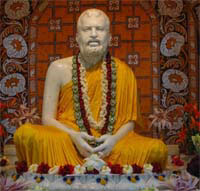Without studying Ramakrishna Paramahamsa first, one can never understand the real import of the Vedas, the Vedanta, of the Bhagavata and the other Puranas. His life is a searchlight of infinite power thrown upon the whole mass of Indian religious thought. He was the living commentary to the Vedas and to their aim. He had lived in one life the whole cycle of national religious existence in India
 His [Sri Ramakrishna’s] life enables us to see God face to face. No one can read the story of his life without being convinced that God alone is real and that all else is an illusion.’ – Mahatma Gandhi
His [Sri Ramakrishna’s] life enables us to see God face to face. No one can read the story of his life without being convinced that God alone is real and that all else is an illusion.’ – Mahatma Gandhi
This celebration of religious diversity – alongside of toleration and pluralism – remained prominent in India
The life of Sri Ramakrishna was an extraordinary search light under whose illumination one is able to really understand the whole scope of Hindu Religion. He showed by his life what the Rishis and Avataras really wanted to teach. The books were theories, he was realization. This man had in fifty one years lived the five thousand years of national spiritual life. – Swami Vivekananda
The life of Sri Ramakrishna was an extraordinary search light under whose illumination one is able to really understand the whole scope of Hindu Religion. He showed by his life what the Rishis and Avataras really wanted to teach. The books were theories, he was realization. This man had in fifty one years lived the five thousand years of national spiritual life. – Swami Vivekananda
He [Sri Ramakrishna] did not pose as a philosopher or a scholar. . . He was a common Hindu. He did not say, ‘I do not believe in idol worship. I am a Vedantin.’ He did not say, ‘I do not believe in going to temples. I believe only in the Upanishadic form of Hindu religion.’ He did not make any statement like that. He was simply like a blade of grass, like any other blade of grass in this country.
There was nothing different about him from the rest and he did not, so to say, assume the air of ‘I am not the blade of grass, I am a mango tree or I am a coconut tree’ or something like that. He was like the grass that grows on earth, not distinct from any other grass, but like the rice plant, which is also, a grass but which yields rice. Sri Ramakrishna was the type of grass which yielded fruit and food in the form of true religion. He was truly a rice plant. May we grow more and more of grass of that variety in our country, and yet more of them. C Rajagopalachari.
The man whose image I here evoke was the consummation of two thousand years of the spiritual life of three hundred million people . . . He was a little village Brahmin of Bengal, whose outer life was set in a limited frame without striking incident, outside the political and social activities of his time. But his inner life embraced the whole multiplicity of men and Gods.’ - Romain Rolland, the French Nobel Laureate.